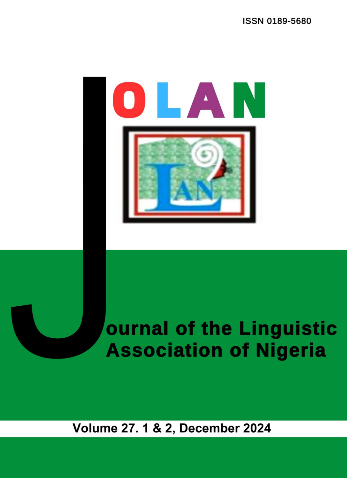A Comparative Survey of the Articulation of English Fricatives among Hausa/Fulani in some Selected Secondary Schools in Gombe
Keywords:
Fricatives, Interference, Glottal, Articulation, palate alveolarAbstract
English language pronunciations in ESL are a problem to both the teachers and the students, especially the ethnic groups in northern Nigeria. The study made a comparative investigation of the English fricatives among Hausa/Fulani by teachers and students of Senior Secondary School in Gombe metropolis. Some of the English fricatives do not exist in the first language of the teachers and students, and a researcher being a teacher noticed a great variance in the articulations of the English phonemes by teachers and students in their spoken English. The various English fricatives (labio-dental, dental, and alveolar, palatal alveolar and glottal) were looked into, to investigate the difference in the teacher’s articulation of the nine fricative phonemes. A test was designed, of individual words, ten (10) sentences and a reading passage with fricatives in the initial, medial and final position to assess their articulations in the various environments. Fifty (50) students and twenty (20) teachers were sampled and each was presented with the task of articulating ninety (90) fricatives in different positions of the words. Descriptive analysis and comparison of two population proportions were used. The findings show that the wrong articulations of the fricatives by teachers and students are often the replacement of the voiceless with the voiced phonemes of the same fricative due to influence of MT of the study population. The voiced dental fricative / ð / is often replaced by the voiceless alveolar plosive /t∫/, the voiceless palatal alveolar fricative is replaced by voiceless palatal alveolar affricative /t/ and voiced alveolar fricative /d/. The wrong articulations of the fricatives by the teachers and students were the same except the students have a greater percentage of wrong articulations. Finally, learning of oral English should be made compulsory in all the teachers training programmes and pronunciation should be given emphasis in the teaching and learning of English at all levels of education.
References
Aladeyomi & Adetunde, (2007), Errors of segmental phonemes in spoken English of Nigeria television: The social sciences 2(3) Medwell Journal Outline.
Aliyu, (2001), Professional Outlet to Languages”.Effective Language Teaching, School of Languages, Federal College of Education, Zaria.
Awobuloyi, (1998) “Language education in Nigeria: Theory, policy and practice” Fafunwa Foundation Internet Journal of Education. Pp 7-9
Bamgbose, (1971), The English language in Nigeria’ in Abdul N. And Issa ,O (1991) Some learning difficulties in spoken English of Nigeria Students.Teaching and Speaking Skills among Second language learners. Magazine for Language professionals.
Banjo, Adeyelole, &Ndahi (1997), Exams focus English for WASSCE and SSCE: University Press.
Bowen, (1972).Contextualising pronunciation practice in the ESOL classroom: TESL Quarterly 6, pp 83 – 94
Cruttenden, (2001).Gimson’s pronunciation of English. 6th Edition: Oxford University Press USA.
Dalton,(2002).some techniques for teaching pronunciation: http:/itesly.org/techniques Dalton Pronunciation html.
Dalton, (1997), Some techniques for teaching pronunciation” The internet TESL Journal Vol. Xii (1). http://itesly.org.
Dunstan, (1969), Twelve Nigeria languages. A handbook sound system for teachers of English: Longman Green and Co. Ltd.
Don-Ifode, A. (1995), Basic phonetics: Publishing Ray Publication Ltd.
Elugbe, (2002), Oral English for schools and colleges: Heinemann Educational Books. (Nigeria) Plc.
Hall, S. (1997), Pronunciation of fluency in presentation skills.Paper Presented at the Annual Meeting of Teachers of English Speakers of Other Languages: http//www.personal une.educt.hfraser/does/hfchange opp.pdf.
Jibril, (1982). Phonological variant of Nigeria languages: An Unpublished Ph.D Thesis, University of Leeds.
Jowitt, (1991), Nigerian English language, An introduction: Longman Nigeria Plc
Keyas, & Walker, (2002). Ten questions on the phonology of English as an International Language: ELT Journal Vol. 4 No. 2
Lodefoged, (1982).A course in phonetics: Harcourt Brace Jovanovich, Publishers, U.S.A.
MOE (2011) Gombe State Ministry of Education Evaluation and Monitoring Unit.
Nasr, (1979), Applied English phonology: for ESL/EFL teachers: University Press America Inc.
Nutt, (2009), Common pronunciation issues in ESL: http.//www.article base/educationarticle/common pronunciation issues in ESL 909671.html.
NOUN Material (2008), Eng. 108: Introduction to English as a second language: National Open University of Nigeria Lagos.
NTI/PTTP (2000), Introduction to Oracy skills (speaking skills) Course Book on English Language for Universal Basic Education (UBE): National Teachers Institute Kaduna
O’Connor, (2000).Better English pronunciation: Low price edition, Cambridge University Press.
Onuigbo, (1979), Oral English for schools and college: African publishers Limited Nig.
Ohata, (2004).Characteristics phonological differences between Japanese and English Asian EFL Journal Vol. 6 issue 4 article 5.
Roach (2002), 3rd Edition English phonetics and phonology: Cambridge University Press.
Shelly (2009), Teaching English pronunciation to ESL student TEFL www.teachingenglishgames.com
Wei, (2008), Investigation on non-English majors proved that language anxiety is negatively associated with the students spoken English: Ceica Journal Vol.31 No.2.
Wells, (2000).Overcoming phonetic interference: Journal of the English phonetics society of Japan. http://www .phone.ucl.ac.uk/home well/interference.atm.














